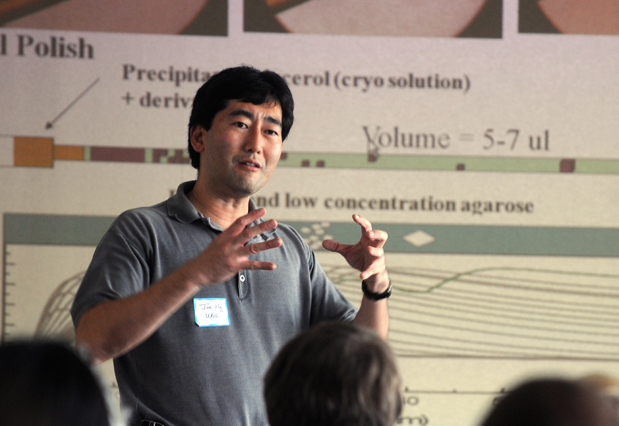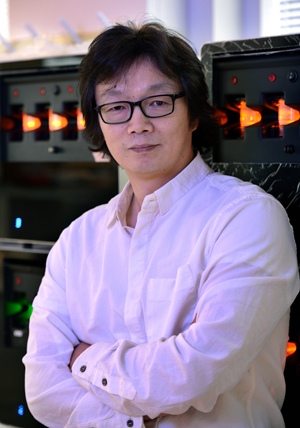Ever since the human genome was unraveled in 2001, genetic science has exploded into a race to find new products and services.
In Alabama, researchers are using worms, synthetic genes, T cells and duplicating tests to recreate the way we diagnose and treat disease. These scientists seek to improve our health and safety, and hope, ultimately, that their life’s work makes life better for us all.
GUY CALDWELL
“Roll Nucleotide!” unabashedly nerd puns the website of the Caldwell Lab, one of the most advanced biomedical laboratories in the state.
Guy Caldwell recruits his superstar team with the same techniques used by another local recruiter — Nick Saban. The University of Alabama professor and researcher tells potential new lab rats that it takes hard work on nights and weekends, and it will be the defining feature of your college career.

|
“And more important than football, ” confesses the Ph.D. researcher and avid sports fan, who keeps two seats from Yankee stadium in his office and forces Red Sox fans to sit in them.
While his award-winning research into neurological diseases matters greatly, almost more satisfying is tapping into the unexploited energy of students. A student from Boaz, the son of two factory workers, is set to be his Heisman winner equivalent, heading to the big leagues of research. Former students have landed jobs and admission to professional programs at M.I.T., UCSF, Duke, Vanderbilt, Princeton, Stanford, Rockefeller, UC-Berkeley, UT-Southwestern, Emory, Oxford, Cambridge and Georgetown. Caldwell’s own mentor won a Nobel Prize.
Caldwell works with his soul mate and wife of 23 years, Kim Caldwell, also a Ph.D., in the Caldwell Lab, nicknamed the Worm Shack. The duo met in graduate school and dreamed of a “mom and pop” shop where they could share their research.
Their lab works with “the most understood animal on the planet.” The much-studied worm, called c. elegans, is a transparent, simple animal with a well defined neuronal map — making it ideal for study of diseases associated with neuronal dysfunction and aging. Compared to the worm’s 302 neurons, the human brain has 100 billion nerve cells.
Besides, “No one is willing to donate living brains to science, ” says Caldwell.
C. elegans is a model system for discovering gene function in diseases of the nervous system. Caldwell and his cohorts use the worm to study brain and movement disorders, such as Alzheimer’s Disease and ALS (Lou Gehrig’s Disease). QRX Pharma invested in a multi-million-dollar contract in their laboratories for drug discovery treatments for Parkinson’s and dystonia.
“The economic burden and quality of life issues with these diseases are extraordinary, ” says Caldwell.
Recent work in the Caldwell Lab is funded by grants from the NSF, NIH, Howard Hughes Medical Institute, Michael J. Fox Foundation and numerous other biomedical foundations and patient support groups.

Joe Ng works with synthetic genes, developing organisms for a range of purposes, from fighting cancer to cleaning up oil spills.
Photo courtesy of University of Alabama in Huntsville
JOE NG
Scientist or engineer? Both, in the case of Joe Ng, Ph.D., professor at the University of Alabama in Huntsville (UAH) and the president of a biotechnology company.
“I am just trying to fit in, so I like to pretend I am an engineer, ” Ng jokes.
He began as a structural biologist, examining the atomic structure of proteins. As a biochemist, he used three-dimensional structures to study his targets. While working in France for a European space agency, he made the leap to Alabama’s space city, Huntsville, where UAH fields a strong engineering department.
Using engineering techniques, Ng works with synthetic genes not found in nature to redesign organisms. The new forms can serve as a cancer vaccine or an oil eater after an ocean spill.
 |
“We can actually make life forms from scratch, ” says Ng. However, his focus is to modify genomes to craft biological tools.
Ng begins with “black smokers, ” thermal vents that heat deep sea water nearly to boiling. The organisms living here survive extreme conditions, making them excellent candidates to use in genetic products. Ng’s company, iXpressGenes, creates solutions for medicine, the environment and defense.
An example of how the system works is this: dogs detect drugs in airports better than any screening technology. If you take the dog’s nose sensor genes and implant them into test molecules, you can create a super sensitive test for explosives even in diluted trace amounts. Add florescence from jellyfish, and the screening tool would change color to indicate explosive ingredients, or contamination in water, or cancer cells — the list goes on.
“It is like a shark that can detect blood miles away, even though it is very diluted. That way, you can catch dangerous substances at a low level, before it becomes dangerous, ” says Ng.
Funding for the research comes from grants awarded by NASA, National Institutes of Health and the National Science Foundation. iXpressGenes is located in the HudsonAlpha Institute for Biotechnology, along with 20 other for-profit companies.

Casey Weaver hopes his research can find ways to prevent immune system diseases.
Photo courtesy of University of Alabama at Birmingham
CASEY WEAVER
A year off from school did not help as much as a mentor did for Casey Weaver, M.D. Debating between the lab and the clinic, he discovered a med school professor exploring the mysteries of the immune system. After graduation, he joined the staff of a renowned immunologist for his pathology residency and, soon after, followed one of his co-workers to the University of Alabama at Birmingham.
Still mesmerized by the complexities of the immune system after 21 years, he studies why immune cells err and attack the body they are designed to protect. Diseases such as lupus, rheumatoid arthritis, inflammatory bowel disease, Type I diabetes and multiple sclerosis — all are caused by rogue cells, such as CD4 T.
“Sometimes it makes a mistake. We want to find out how the cells make decisions, for better or worse, ” says Weaver.
Most immune cells remain quiescent in the body — always prepared to mount an immune response. If the process of awakening can be understood, interrupting the abnormal response is possible. Switching genes on and off could reprogram misdirected cells.
“I have always felt, if you ultimately wanted to intervene, you had to get to the heart of the matter and find the primary players, ” Weaver says.
In 2005, he contributed to the discovery of a new pathway T-helper 17 cell, which is linked to many of the autoimmune diseases.
Since then, he has consulted with a number of pharmaceutical companies and helped launch a start-up company in Boston, devoted to immune-related diseases of the eye. The company just completed its first small clinical trial and is set for Phase II of its first product. Fundraising is in progress to push the therapy to the next level.
“Hopefully, they can make a difference, ” says Weaver.

|
JIAN HAN
Physician, scientist, inventor and entrepreneur — a rare combination found in a single person. Jian Han, M.D., Ph.D., qualifies with a long list of accomplishments, but boasts of being the first investigator hired by HudsonAlpha Institute for Biotechnology in Huntsville.
“It is the science of progress. You give value when you implement science into the marketplace, ” says Han, reflecting the philosophy of HudsonAlpha.
Along with his discoveries runs a list of companies using his inventions. Only Diatherix has advanced into clinical trials so far, but Genaco, iCubate and iRepertoire are also successful companies spawned from his technology.
His primary research application is the multiplex PCR, a way for a medical lab to run multiple tests on a single blood sample. The multiplex can run 20 to 30 tests at once.
The advanced multiplex was tested at Huntsville Hospital to stunning results — the technology shaved off an average of 3.5 days of hospitalization.
“That is the power of a technology putting patients on the right therapy sooner. The whole society benefits from reduced medical costs and saved lives, ” says Han.
His new test, the iCubate System, has reduced the lab test from two rooms and a microbiologist, to a cassette and 10 minutes of training. iCubate has sold eight of the relatively inexpensive testing devices and is raising the capital to fill 20 more orders. Customers include NASA, USDA and the Chinese version of the Centers for Disease Control.
New research targets reading the immune system, which Han considers the master biologist when it comes to detecting disease cells.
Testing runs deep in the Han family. His father created a prenatal test to diagnose fetal problems in the first trimester. Jain Han first gained fame by inventing a multiplex test to determine Severe Acute Respiratory Syndrome (SARS).
The challenge, he says, is keeping tests up to date. “The government will never work as fast as a virus.”
Verna Gates is a freelance writer for Business Alabama. She lives in Birmingham.
Text by Verna Gates



